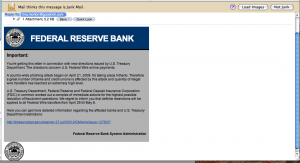How to detect phishing e-mails
This post is by no means complete. It’s only a guide for how to determine if an e-mail you got is phishing or not. There is a game we discussed before – Anti-Phishing Phil – that can help test your skills.
I got the following e-mail in my junk mail folder.

The e-mail looks official, and the link even goes to where it says it goes. So, how do I know this is a phishing e-mail?
- This is supposed to be from the US Federal Reserve System. Most Americans do not use phrasing like “hitherto and therefore”. Listen to your British/Australian/Indian counterparts and you’ll hear this type of language though.
- Bad grammar – “banks and credit unions is”.
- The link leads to a site called secureserver-27, the Fed’s web page is http://www.federalreserve.gov
- The e-mail is *not* from federalreserve.gov. If they were sending out official e-mail, do you think they’d allow an employee to send from their personal e-mail account?
Above and beyond these items, if you look at the headers of the e-mail, you can see that Spam Assassin flagged it as including blacklisted URLs.

Spam Assassin gave this a score of 9.2, at 4, my server marks it and dumps it to the spam folder, at 10, my server outright rejects the SMTP connection. This e-mail is pushing it pretty close to that.
In summary, watch for strange language, bad grammar, misspellings, and strange links. And any e-mail where the text doesn’t match where the link goes to. If in doubt, assume it’s spam. If it’s from a company you normally do business with (like your bank), give their main number a call and ask about it – don’t use any phone numbers or e-mails given in the suspect e-mail. Always use the phone number on the back of your credit/bank card, or from one of your statements.
2 thoughts on “How to detect phishing e-mails”
Here’s a simple approach that will never happen: e-mail clients should, by default, not allow hyperlinks in messages, and bury that setting deep enough that only people who know what they’re getting into can enable single-clicking.
Of course, this will just make the scammers put in detailed instructions for how to “fix” the setting.
Maybe we need a test like the drivers license test before people are allowed to bank online…
Which is some inspirational stuff. Certainly not knew that opinions may be this varied. Cheers for each and every just one from the enthusiasm to offer you such incredibly very helpful info in this posting.
Comments are closed.